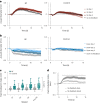Self-regulating arousal via pupil-based biofeedback
- PMID: 37904022
- PMCID: PMC10810759
- DOI: 10.1038/s41562-023-01729-z
Self-regulating arousal via pupil-based biofeedback
Abstract
The brain's arousal state is controlled by several neuromodulatory nuclei known to substantially influence cognition and mental well-being. Here we investigate whether human participants can gain volitional control of their arousal state using a pupil-based biofeedback approach. Our approach inverts a mechanism suggested by previous literature that links activity of the locus coeruleus, one of the key regulators of central arousal and pupil dynamics. We show that pupil-based biofeedback enables participants to acquire volitional control of pupil size. Applying pupil self-regulation systematically modulates activity of the locus coeruleus and other brainstem structures involved in arousal control. Furthermore, it modulates cardiovascular measures such as heart rate, and behavioural and psychophysiological responses during an oddball task. We provide evidence that pupil-based biofeedback makes the brain's arousal system accessible to volitional control, a finding that has tremendous potential for translation to behavioural and clinical applications across various domains, including stress-related and anxiety disorders.
© 2023. The Author(s).
Conflict of interest statement
S.N.M., M.B. and N.W. are founders and shareholders of an ETH spin-off called ‘MindMetrix’ that aims to commercialize pupil-based biofeedback, and have a patent application related to the method of pupil-based biofeedback (patent applicant: ETH Zurich; inventors: M.B., S.N.M., N.W., pending patent applications EP21704565.7 and US17/800,455). All other authors declare no competing interests.
Figures







Similar articles
-
Modulating cortical excitability and cortical arousal by pupil self-regulation.Nat Commun. 2025 May 16;16(1):4552. doi: 10.1038/s41467-025-59837-5. Nat Commun. 2025. PMID: 40379647 Free PMC article.
-
Pupillometry and P3 index the locus coeruleus-noradrenergic arousal function in humans.Psychophysiology. 2011 Nov;48(11):1532-1543. doi: 10.1111/j.1469-8986.2011.01226.x. Epub 2011 Jul 18. Psychophysiology. 2011. PMID: 21762458
-
Role of the locus coeruleus arousal system in cognitive control.J Neuroendocrinol. 2020 Dec;32(12):e12890. doi: 10.1111/jne.12890. Epub 2020 Aug 20. J Neuroendocrinol. 2020. PMID: 32820571
-
Pupil Size as a Window on Neural Substrates of Cognition.Trends Cogn Sci. 2020 Jun;24(6):466-480. doi: 10.1016/j.tics.2020.03.005. Epub 2020 Apr 21. Trends Cogn Sci. 2020. PMID: 32331857 Free PMC article. Review.
-
Orienting and reorienting: the locus coeruleus mediates cognition through arousal.Neuron. 2012 Oct 4;76(1):130-41. doi: 10.1016/j.neuron.2012.09.011. Neuron. 2012. PMID: 23040811 Review.
Cited by
-
Paced Breathing Associated With Pupil Diameter Oscillations at the Same Rate and Reduced Lapses in Attention.Psychophysiology. 2025 Feb;62(2):e70003. doi: 10.1111/psyp.70003. Psychophysiology. 2025. PMID: 39905564 Free PMC article.
-
eyeris: A flexible, extensible, and reproducible pupillometry preprocessing framework in R.bioRxiv [Preprint]. 2025 Jun 3:2025.06.01.657312. doi: 10.1101/2025.06.01.657312. bioRxiv. 2025. PMID: 40501763 Free PMC article. Preprint.
-
Distinguishing the activity of adjacent somatosensory nuclei within the brainstem using 3T fMRI.Imaging Neurosci (Camb). 2025 May 12;3:imag_a_00581. doi: 10.1162/imag_a_00581. eCollection 2025. Imaging Neurosci (Camb). 2025. PMID: 40800778 Free PMC article.
-
Decision-making dynamics are predicted by arousal and uninstructed movements.Cell Rep. 2024 Feb 27;43(2):113709. doi: 10.1016/j.celrep.2024.113709. Epub 2024 Jan 26. Cell Rep. 2024. PMID: 38280196 Free PMC article.
-
Oscillations of the Wandering Mind: Neural Evidence for Distinct Exploration/Exploitation Strategies in Younger and Older Adults.Hum Brain Mapp. 2025 Apr 15;46(6):e70174. doi: 10.1002/hbm.70174. Hum Brain Mapp. 2025. PMID: 40287841 Free PMC article.
References
MeSH terms
Grants and funding
- CRSK-1_190836/Schweizerischer Nationalfonds zur Förderung der Wissenschaftlichen Forschung (Swiss National Science Foundation)
- 32003B_207719/Schweizerischer Nationalfonds zur Förderung der Wissenschaftlichen Forschung (Swiss National Science Foundation)
- Bridge Discovery (SNF/Innosuisse); 40B2-0_203606/Schweizerischer Nationalfonds zur Förderung der Wissenschaftlichen Forschung (Swiss National Science Foundation)
- Postdoctoral Fellowship Program/Eidgenössische Technische Hochschule Zürich (Federal Institute of Technology Zurich)
- CREATE programme/National Research Foundation Singapore (National Research Foundation-Prime Minister's office, Republic of Singapore)
LinkOut - more resources
Full Text Sources

